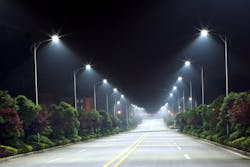Street lights are one of the many ubiquitous features of the roadway landscape in this country that get taken for granted by motorists of all stripes, including truckers.
Yet the boring, little-thought-about street light serves a very important role in transportation, as many truckers hauling freight in the middle of the night can attest.For how much more difficult would a trucker’s job be if there wasn’t enough light at night for loading and unloading, for navigating tight city streets for make oh-dark-thirty deliveries to grocery stores, or to provide a farther view down the long stretches of asphalt ahead at 1 a.m.?
But remember, too, those wonderful street lamps require electricity to function – electricity that gets generated by power plants that are increasingly being bound ever more tightly by ever more stringent regulations.
Thus electrical capacity is slowly diminishing, which could lead to a rise in prices – and thus leaving municipalities and other government entities to figure out a way to keep the lights on without breaking the bank.
Interestingly, lighting technology long used on commercial trucks is now stepping into the street light situation and may – and I stress “may” here – provide a “have your cake and eat it too” solution.
Light-emitting diodes (LED) are commonly used in truck and trailer lights of all shapes and sizes, but according to a survey of 100 cities and municipalities across the U.S. that have implemented some form of LED streetlight initiatives, they can save on average nearly 60% in combined energy and maintenance costs.
Put another way, LED lighting generally consumes just 1% of the electricity used by current street light technology – typically fired by mercury- or sodium-vapor bulbs – with each LED light unit lasting about 100 times or more longer than regular lights.
That could generate some big savings for municipalities and other entities charged with providing nighttime illumination of roadways.
The study – dubbed United States Smart Infrastructure: LED and Smart Street Lighting and authored by Washington, DC-based research firm Northeast Group – noted that law enforcement officials in particular offered praise for LED street lights for improving visibility and public safety.
The firm added that success of LED street light projects is also helping to set the stage for more advanced “smart” street lighting systems, which could reduce energy consumption by a further 20% to 30%.
By “smart,” the firm references the LED streetlight’s ability to turn on and off nearly instantly as well as its “dimming” capability – something traditional street lights can’t do. This enables cities to install “smart” features to streetlights, which further reduce energy consumption through dimming, improve billing, and enable remote monitoring features, Northeast said in its report.
Thus, cities that already installed communications networks for related “smart grid” infrastructure can take advantage of those LED capabilities and lower streetlight operating costs even further.
Of course, it should be stressed that LED street lights are nowhere near attaining “slam dunk” status – not by a long shot. That’s in part because their initial cost is much, much higher, averaging between $250 and $500 per LED unit compared with $125 to $300 for “traditional” street light bulbs.Northeast Group also discovered via its survey that 45% of respondents had funded their LED streetlight projects almost entirely with monies from the American Recovery and Reinvestment Act (ARRA) – the infamous “stimulus bill” passed during the early days of Obama's first term.
A further 36% relied on ARRA funding or other grants for at least a portion of their financing, Northeast discerned, leading it to conclude that as stimulus funding recedes, financing for future LED streetlight projects is going to be more difficult to secure – despite the success of early projects. Indeed, LED penetration of the street light market remains below 1% of the overall streetlight population in the U.S., the firm found.
However, Northeast figures that as the price of LED streetlights continues to steadily fall, it should reach parity with “legacy” street light technology within a few years – meaning that the payback period for switching to LEDs should become far more favorable and thus be within the reaches of budget-constrained cities and municipalities, the firm said.
In the end, if truckers get good light to work by, produced at a far cheaper cost to the cities and towns that provide it, everyone comes out a winner. At least, that’s the hope where streetlights are concerned.





